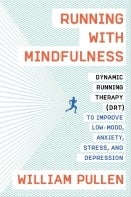Runners often talk about a "runner's high"—that euphoric feeling they get after prolonged exertion. William Pullen, who developed Dynamic Running Therapy, says we can use this feeling for therapeutic purposes to help manage stress, anger, depression and other conditions. His book, Running with Mindfulness: Dynamic Running Therapy (DRT) to Improve Low-mood, Anxiety, Stress and Depression (Plume; Sept. 26, 2017), describes his method of mindfulness, focused questions and exercise in an interactive workbook format that helps readers heal and reclaim their lives.

I had the pleasure of talking with William Pullen, who is based out of London, about the success he's had with DTR in helping people leave their anxieties behind.
How did you discover Dynamic Running Therapy?
I was going through a personal crisis after a relationship ended. I found myself unable to either address or understand my reaction on my own, so I sought help from a therapist and took up running. Luckily, I had a friend who was also going through a struggle at the time and we ran together. I discovered the enormous benefit of running while exploring feelings.
What makes DRT effective?
It gives users a powerful sense of agency in their own recovery—each kilometre they cover represents commitment and progress. In this sense, it's a physical enactment of one's desire and willingness to recover or grow. Couple this with the sense of accomplishment that comes from racking up the kilometres (even if you start with short distances as I did), and a growing confidence provides the kind of momentum that facilitates change. The fresh air and physicality is particularly rewarding for those who are anxious or depressed.
Running and walking can help us find both understanding and focus. For those who are confused or overwhelmed, it can provide clarity and a sense of empowerment.
Can DRT be tailored to people who aren't runners?
Absolutely. An engaging walk that gets the blood moving can result in the same sense of engagement, commitment and progress.
What goes into recruiting a partner for sharing your DRT experience?
You don't have to have a partner to do DRT. One of its strengths is the ability to explore your situation alone. However, having a partner can make the experience easier or more comfortable for many. As far as getting the right partner, I suggest making a list of your requirements beforehand and seeing who might fit. It's important to take into consideration age, gender, fitness and the nature of their relationship to you. Ideally you want to be with someone you feel comfortable with. They may end up knowing a lot about you, so you need to feel a reasonable degree of trust. Finally, you want to come to an understanding of how you'll work your DRT: place, time, who takes the first turn, boundaries, how much anger or how many tears are permitted... Also, decide what happens if one person decides to finish, and the other isn't there yet.
Who has been helped through DTR?
I've seen DTR help just about every sort of person. It's essentially just drawing on our innate biological and sociological desire to share when moving. We may spend much of our lives in chairs these days, but we still have the souls of hunter-gatherers.
Learn more at dynamicrunningtherapy.com
